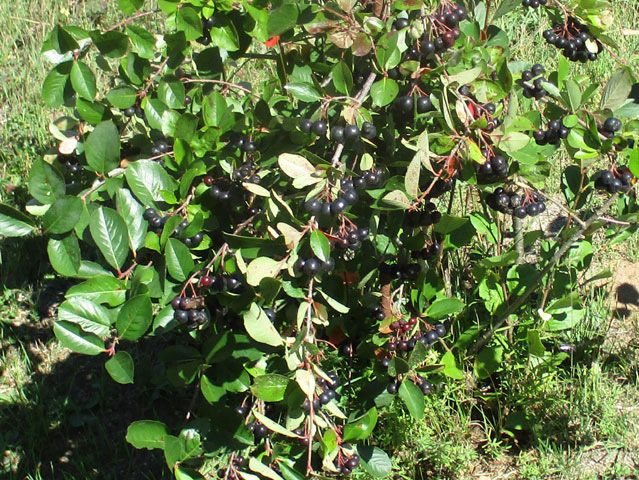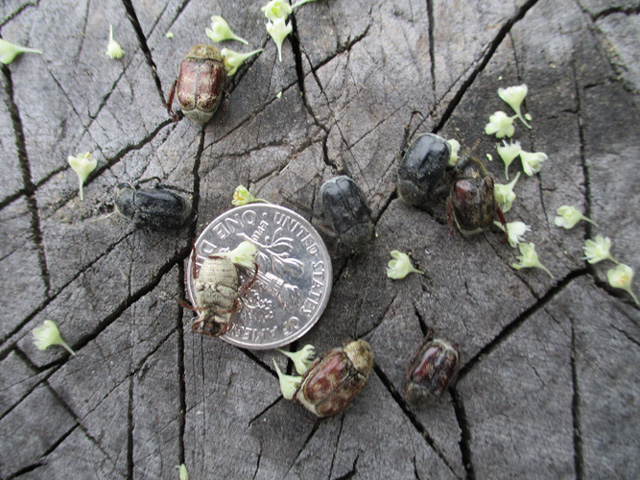|
| ||
|
Apples
Blueberries |
The ManyTracks Orchard Aronia - Viking and McKenzie
aka Black Chokeberry -- Aronia melanocarpa
Four decades of Growing
Good Food
in Michigan's Upper Peninsula |
|
|
Aronia is native to the Great Lakes region and I have seen a few in a nearby wetlands. It has only relatively recently gained attention as a commercial fruit so not a lot of breeding or selecting has been done in this country, much more in the Eastern European countries. It isn't a typical fresh eating sweet juicy fruit, but somewhat dry and astringent until very ripe when it is not a bad minor nibble in the orchard but one probably not often eaten fresh. But its berries are full of healthy attractive nutrients (very dark ones!) and the juice has become more common in commercial products. It is a plant that makes sense to grow here. It's hardy, easy, healthy, insect loving bloom machine, edible and attractive. I appreciate it for all of that. I'm growing two varieties: Viking is the most common, readily available from online nurseries, a European variety that it is said is not pure A.melanocarpa but crossed with Sorbus aucparia - European Mountainash. I don't think that matters much as there is little genetic diversity amongst all of the current varieties, whether selections or hybrids. They are all similar. McKenzie was collected in the former Soviet Union and introduced by Natural Resources Conservation Service Plant Materials Center, Bismarck ND. I got mine as little starts from a North Dakota GrowingFruit forum member. It is a smaller plant than Viking but the fruit is very similar. 2023 - All plants did fine with little attention and little watering (record hot, dry May and June). Harvested most late and dried for tea and to put in applesauce later. Tied large McKenzie up to stake in center to keep fruit off ground; worked well. May 15 grafted a dormant L'Anse scion onto a fairly sturdy north cane (leaves already growing); took and grew nicely about 6". Interesting experiment!
We had a bumper crop of heavy
bodied insects in the thick blooms of Viking in early June, and a lesser number
in McKenzie [as well as in rhubarb blooms].
Looked like some kind of weevil so I figured I should clear them out. I
patiently picked and knocked them into jar of soapy water. A few days later I found more and again removed them. I
couldn't find an ID online and finally checked with a very knowledgeable
GrowingFruit forum member. He suggested that they were "scarab beetles, probably one of
the fruit and flower chafers. All scarabs are built like tanks
But back to fruit. It was a great year. Early September I picked 4 quarts off the two plants, more off the older larger Viking. They are so wonderfully easy to pick, if one doesn't mind dark purple stained hands! I simmered the fruit, strained, put some in apple vinegar I was making and canned the rest - 7 half pints - to add to applesauce later. It adds nice color, nutrients and flavor. Next year I'll leave more on the plants to put in sauce as I make it. The berries that I had left hanging this year did just fine late into the season. 2021 - McKenzie - Looking good, outer #2 plant smaller but nice growth on both. Viking - Beautiful dark purple-black berries on #1 plant, harvested 3 cups August 19. Cooked and canned, added later to applesauce. Intense color! Definitely darkens sauce, adds a bit of flavor. A few berries on #2, too. 2020 -McKenzie - Though small I planted them out in the orchard spots 4/28. One inside fence in main orchard between BlOx and Honeyc. Other in outer NEOrchard between heartnuts. Viking - Both looking good, #1 larger but then it gets more care and attention. 2019 - McKenzie - received small rooted cuttings from a North Dakota Growing Fruit forum member in the fall. Seeds from the initial evaluation planting site in North Dakota where the original plants were established in 1976 by the USDA. Prefers full sun but will tolerate some shade and still fruit. Put little plants in greenhouse, potting up once over winter. Had some issues but planted in nursery outside in spring. Recovered nicely, 6" and 8" growth. Viking - Purchased #1 plant from IndianaBerry, planted inside fence NE corner. Purchased #2 from HoneyberryUSA, planted in NEOrchard, east edge. Copyright © Susan Robishaw |
||


